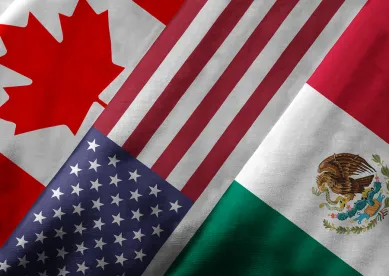In fulfillment of one of its campaign’s central promises, the Trump administration has moved forward with its commitment to renegotiate the North America Free Trade Agreement (NAFTA). While candidate Trump spoke broadly of border taxes, increased duties on imports, and other measures intended to make imports more costly and boost U.S. manufacturing, President Trump has been more reserved in addressing the administration’s actual trade priorities and goals. Because many retailers depend on supply chains that are heavily embedded in Mexico and Canada, the retail industry stands to be significantly impacted by the outcome of the renegotiations.
The renegotiation of NAFTA may present challenges to the status quo, but it will also provide new opportunities for retailers. Below we review the possible impact of some potential changes to the agreement, as well as the opportunities for modernization that can benefit retailers industry-wide.
Out With the Old? – NAFTA Rules of Origin
Among the most contentious issues that may be renegotiated is the NAFTA rules of origin. The NAFTA rules of origin are product-specific rules that determine whether imported goods can be considered NAFTA-originating and therefore eligible for preferential (duty-free) treatment. Many U.S. companies have dedicated significant resources to establishing and supporting sourcing relationships in Mexico and Canada based on the duty-free treatment accorded to imports from the NAFTA region. Even slight changes to the NAFTA rules of origin could significantly impact these established relationships and force costly supply chain or system changes.
In its recently published summary of objectives for the NAFTA renegotiation, the Office of the United States Trade Representative (USTR) indicated that the administration plans to “[u]pdate and strengthen the rules of origin, as necessary, to ensure that the benefits of NAFTA go to products genuinely made in the United States and North America” and to “[e]nsure the rules of origin incentivize the sourcing of goods and materials from the United States and North America.”1 While the summary did not address whether the USTR’s negotiation priority will be to enhance regional value content (RVC) requirements for NAFTA qualification across the board, the goal of “strengthening” the rules to increase North American sourcing certainly would require at least targeted increases to the RVC.
RVC requirements are applied on a product-specific basis and set a required percentage of “originating” content, meaning inputs that originate in Mexico, Canada or the U.S. are needed to make the imported product eligible under NAFTA. The product-specific nature of the qualification rules makes them particularly important, as the administration can target product groupings or commodities for which it considers North American sourcing to be particularly important. This would likely happen for products that may include major components sourced outside the NAFTA region. However, not all products are subject to an RVC qualification under the current NAFTA rules of origin.
For example, a U.S. retailer may purchase portable gas grills that are manufactured in Mexico using mostly Mexican origin components and parts, but that include steel grill bodies that make up 40 percent of the cost of the grill and are sourced from China. To date, the importer would have received a NAFTA certificate of origin from the Mexican company confirming that the exported product is NAFTA-originating and the importer would have made NAFTA claims on these products at importation, avoiding the costly 5.7 percent ad valorem duty associated with portable gas grill imports.
The grills would have previously qualified under NAFTA despite the fact that the steel grill bodies were Chinese. This is because the current product-specific NAFTA rule of origin for portable grills requires a NAFTA RVC of at least 50 percent based on the net cost of the good. The other 50 percent of the costs can be sourced from outside the NAFTA region and still be considered NAFTA-originating.
If the NAFTA renegotiations resulted in an increase of the net cost RVC requirements from 50 percent to, say, 70 percent of NAFTA originating content (materials, labor, overhead), the portable grills would be ineligible for NAFTA duty preferences, as more than 40 percent of the net cost would be of Chinese origin. This change would trigger the 5.7 percent ad valoremduty, forcing sourcing changes to reduce the landed cost or passing the cost on to the retail customer.
Obviously, such a change would impact a significant number of products currently sourced in Mexico and Canada. With increasing costs and slimmer profit margins, retailers that depend heavily on products sourced from the NAFTA region should pay particularly close attention to developments regarding the NAFTA rules of origin, as even slight changes to the RVC or other NAFTA rules of origin can have a direct and measurable impact on the bottom line.
In With the New – Modernization of NAFTA
One of the most important promised updates to the NAFTA agreement is the possible inclusion of a new chapter on digital trade and e-commerce. When NAFTA was first enacted, the internet was in its infancy. Ordering products online, not only from a computer but from a smartphone, was unimaginable.
Today, the internet and e-commerce have dramatically changed the landscape for retailers, but the existing NAFTA agreement does not contain any updated e-commerce or digital trade provisions. The recently announced NAFTA negotiation priorities of the Trump administration seek to change this.
As more of the world’s population become digital buyers, retailers want to be in the best position to facilitate cross-border transactions with these customers. According to UPS, in 2016, global e-commerce reached nearly $2 trillion, of which North America constituted $423 billion — more than the total value of all U.S. exports to Canada in 2016, a figure that has grown more than 14 percent consistently for the last several years.2 American businesses, especially small and medium retailers, can benefit greatly from the inclusion of new NAFTA provisions that facilitate e-commerce transactions.
Some of the provisions that concern e-commerce and digital trade were already negotiated by the United States, Canada and Mexico under the Trans-Pacific Partnership. Therefore, new rules concerning digital trade should not be controversial because all three countries agreed to them previously.
The most important issue to retailers is the goal of the U.S. government to raise the de minimis level for the payment of duties. Specifically, in order to facilitate cross-border e-commerce sales, a specific negotiating priority of the Trump administration is for all three countries to have a similar shipment value of $800 before duties are owed, which is known as a de minimis level.3 Right now, however, Canada has a de minimis level of approximately $15, while Mexico has a de minimis level of approximately $50. These low de minimis levels thwart e-commerce sales by U.S. companies to Canada and Mexico.
In addition to the goal of increasing the de minimis level to $800, another negotiating priority is to streamline customs and trade facilitation. To accomplish that, the Trump administration lists the following goals:
- Increase transparency by ensuring that all customs laws, regulations and procedures are published on the internet as well as designating points of contact for questions from traders.
- Ensure that, to the greatest extent possible, shipments are released immediately after determining compliance with applicable laws and regulations, and provide for new disciplines on timing of release, automation, and use of guarantees.
- Provide for streamlined and expedited customs treatment for express delivery shipments, including shipments above any de minimis threshold.4
If the Trump administration is successful in including these upgrades to a revised NAFTA, it will certainly benefit retailers by streamlining and simplifying the procedures for e-commerce and express delivery shipments. In addition, increasing the de minimis level will likely allow small and medium retailers to tap into markets in the NAFTA region. This would appear to be a win for all of the parties to the negotiation.
1 Summary of Objectives for the NAFTA Renegotiation, Office of the United States Trade Representative, at 8 (July 17, 2017).
2 We Negotiated NAFTA Before E-commerce — Here Are Three Ways to Modernize It, UPS Public Affairs (June 23, 2017) citing eMarketer.com: Worldwide Retail Ecommerce Sales Will Reach $1.915 Trillion This Year; DigitalCommerce360.com Five Years of E-Commerce Growth.
3 Summary of Objectives for the NAFTA Renegotiation at 5.
4 Id.





 />i
/>i

